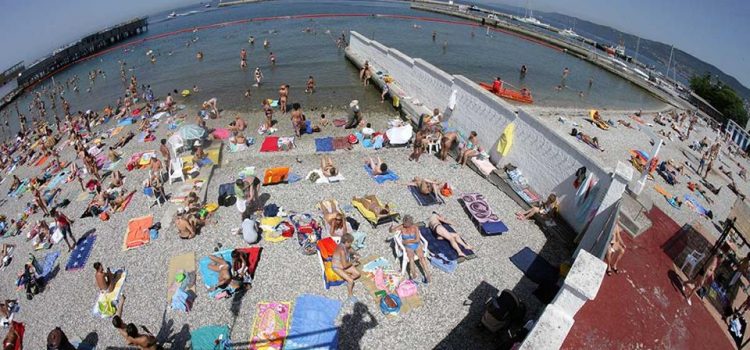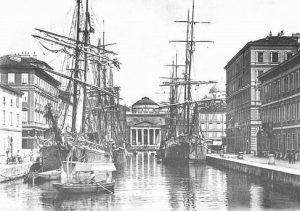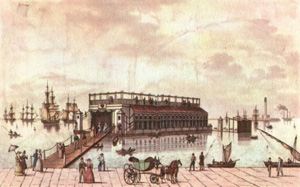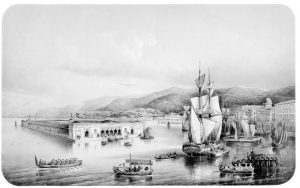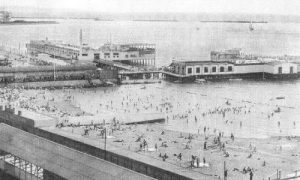All’inizio dell’800 a Trieste fare un bagno era considerata un’attività da incoraggiare per il benessere e la salute dei cittadini.
A Trieste la “tociada” avveniva ancora prima della nascita degli stabilimenti balneari.Ragazzini di Città Vecchia e marinari all’inizio dell’800 solevano tuffarsi nelle acque del porto oppure nel Canal Grande tra una barca e l’altra rischiando di essere investiti da un veliero che trasportava le merci. “Chiunque verrà trovato a nuotare nudo fra un Lazzaretto e l’altro sarà immancabilmente arrestato e punito, ed in quanto a’ ragazzi, gastigati verranno anche con vergate”. La zona incriminata era lo spazio fra il Lazzaretto Vecchio, quello di San Carlo (che sorgeva proprio dove oggi si trova il Museo del Mare) e il Lazzaretto Nuovo di Maria Teresa nella zona di Roiano. Tratto da un “Avviso” che risale al 7 giugno 1809, firmato dal Cavalier Ignazio de Capuano, Preside del Magistrato. ”Luogo di pubblici bagni” quando compariva questa scritta su un palo si poteva fare il bagno.Sicuramente fuori dai lazzaretti e specialmente a Sant’Andrea dove i marinai potevano addestrarsi nel nuoto. Nei primi decenni dell’800 sorsero sullo specchio di mare di fronte alla città, ancorati a zattere, i “bagni galleggianti”, da qui probabilmente deriva il modo di dire dei triestini “andiamo al bagno”.
Il 24 maggio 1823, di fronte a piazza Giuseppina (oggi piazza Venezia), fu aperto il primo stabilimento balneare cittadino il “Soglio di Nettuno”, raggiungibile in barca o su di una passerella. All’interno furono costruite vasche per fare bagni caldi e di acqua dolce, una caffetteria con rinfreschi, un acquario con flora e fauna del golfo e anche una sala per fumatori. Il 13 giugno 1832 il “Bagno” fu visitato dall’ Imperatore d’Austria Francesco I Il proprietario e l’inventore del bagno fu il commerciante Domenico d’ Angeli.
Seguirono la costruzione di altri “Bagni” galleggianti come il “Bagno Maria”, ormeggiato presso il molo San Carlo (oggi molo Audace).Era uno stabilimento galleggiante, costruito in legno, lungo 50 metri per 26 e d’ estate veniva ormeggiato presso il molo San Carlo (oggi molo Audace). Aveva una capienza di duecento persone, riservato,pare, soprattutto ai clienti del lussuoso Hotel “De la Ville”, sulle rive. Era stato costruito al Cantiere San Rocco a Muggia e, qui, in inverno, ci tornava per la manutenzione. Costruito nel 1857, attivo fino al 1911, quando fu distrutto da una tempesta. Il “Bagno Boscaglia” con struttura in legno, ancorato in mare aperto, spesso smontato alla fine della stagione balneare oppure ancorato in Sacchetta d’ inverno. Un apposito vaporetto trasportava i bagnanti al “Boscaglia”.Dopo qualche anno dalla sua inaugurazione, cambiò proprietario e divenne il “Bagno Buchler” e nel 1898 fu ristrutturato completamente e modernizzato. Nel 1891 venne nominato “Galleggiante Nazionale”.Purtroppo il bagno andò completamente distrutto assieme agli altri bagni galleggianti, nella notte tra il 13 ed il 14 giugno del 1911 per un violentissimo fortunale che danneggiò gravemente in molti punti anche le rive, affondando barche e velieri e causando alcuni morti.
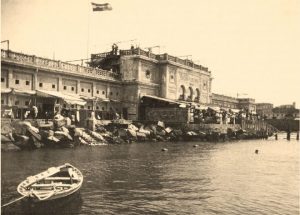 Il “Bagno Fontana” fu costruito verso il 1899 e non era un “Bagno” galleggiante ma ben posizionato a terra nei pressi della Sacchetta. Lussuosamente servito dal tram a cavalli sembra che sia stato distrutto per la costruzione della stazione di Campo Marzio. Joyce cita il Bagno Fontana nella Rubrica di Trieste, in un passo intitolato “Giorgino”, dedicato al figlioletto neonato: «Lo tenevo in mare nei bagni di Fontana e …
Il “Bagno Fontana” fu costruito verso il 1899 e non era un “Bagno” galleggiante ma ben posizionato a terra nei pressi della Sacchetta. Lussuosamente servito dal tram a cavalli sembra che sia stato distrutto per la costruzione della stazione di Campo Marzio. Joyce cita il Bagno Fontana nella Rubrica di Trieste, in un passo intitolato “Giorgino”, dedicato al figlioletto neonato: «Lo tenevo in mare nei bagni di Fontana e …
Alla fine dell’800 la scogliera lungo il molo Santa Teresa (oggi Fratelli Bandiera) era il luogo preferito dalla povera gente per prendere il sole sulle rocce chiamate cape” (come i merletti sugli abiti delle signore). Nei primo del 900 fu costruito il primo stabilimento balneare pubblico, l’inaugurazione sembra sia avvenuta nel 1903 anche se precedentemente esisteva già uno stabilimento balneare, il “Bagno Fortuna”.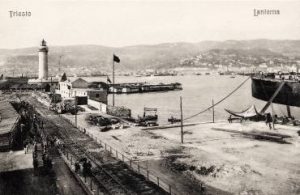
Alla fine dell’800 si avvertiva la mancanza di specifiche strutture permanenti che permettessero soprattutto ai cittadini più indigenti di usufruire dei benefici del bagno. Nel 1903 il Comune di Trieste costruì, nei pressi della scogliera lungo il molo Santa Teresa (oggi Fratelli Bandiera), il primo stabilimento balneare pubblico il “Bagno Alla Lanterna” il cui nome deriva dalla lanterna collocata sul molo nel 1832 come faro marittimo. Il molo, su cui si sviluppa lo stabilimento, poggia sui resti di un’antica struttura di derivazione romana che congiungeva la terra ferma con l’isolotto o Scoglio detto dello Zucco su cui poggiavano le fondamenta del Faro. Il “Bagno” fu poi denominato dai triestini “El Pedocin”, forse perché c’era tanta gente quante cozze (in dialetto “pedoci”) attaccate agli scogli, oppure perchè vi andavano a “spidocchiarsi” i militari o, infine, perchè la gente si
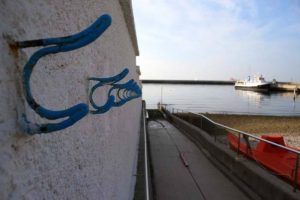 portava da casa i chiodi “Ciodin” (piccolo chiodo) per appendere gli abiti. Fu costruito in legno con tanto di staccionata divisoria fra uomini e donne e le pene contro eventuali sconfinamenti fra le due zone erano molto severe.
portava da casa i chiodi “Ciodin” (piccolo chiodo) per appendere gli abiti. Fu costruito in legno con tanto di staccionata divisoria fra uomini e donne e le pene contro eventuali sconfinamenti fra le due zone erano molto severe.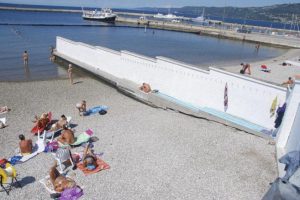
Negli anni ’30 le strutture in legno vennero sostituite col calcestruzzo e nacque così il famoso muro che divide ancora oggi a metà lo stabilimento estendendosi fin dentro il mare. “El Pedocin” rimane l’unico stabilimento balneare in Europa dove un muro separa rigorosamente la spiaggia in due aree, una riservata a donne e bambini al di sotto dei 12 anni e l’altra ai maschi, suscitando la curiosità di giornalisti e turisti provenienti da tutto il mondo.

